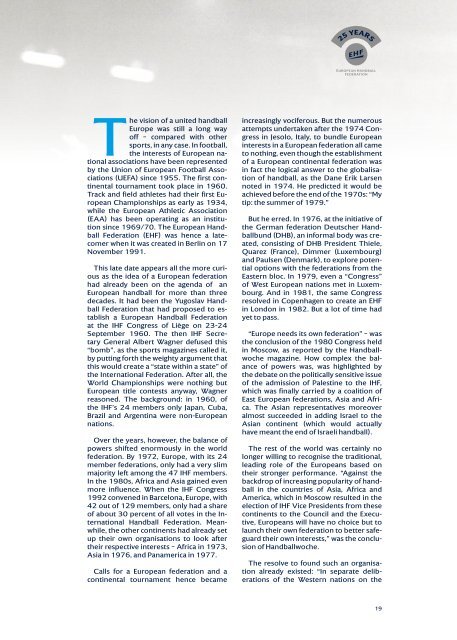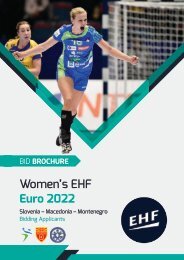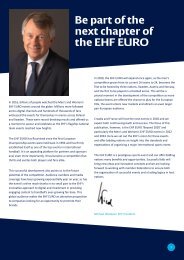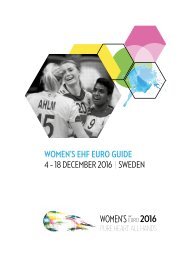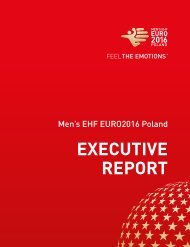ehf_25yers_book_webversion
Create successful ePaper yourself
Turn your PDF publications into a flip-book with our unique Google optimized e-Paper software.
The vision of a united handball<br />
Europe was still a long way<br />
off – compared with other<br />
sports, in any case. In football,<br />
the interests of European national<br />
associations have been represented<br />
by the Union of European Football Associations<br />
(UEFA) since 1955. The first continental<br />
tournament took place in 1960.<br />
Track and field athletes had their first European<br />
Championships as early as 1934,<br />
while the European Athletic Association<br />
(EAA) has been operating as an institution<br />
since 1969/70. The European Handball<br />
Federation (EHF) was hence a latecomer<br />
when it was created in Berlin on 17<br />
November 1991.<br />
This late date appears all the more curious<br />
as the idea of a European federation<br />
had already been on the agenda of an<br />
European handball for more than three<br />
decades. It had been the Yugoslav Handball<br />
Federation that had proposed to establish<br />
a European Handball Federation<br />
at the IHF Congress of Liège on 23-24<br />
September 1960. The then IHF Secretary<br />
General Albert Wagner defused this<br />
“bomb”, as the sports magazines called it,<br />
by putting forth the weighty argument that<br />
this would create a “state within a state” of<br />
the International Federation. After all, the<br />
World Championships were nothing but<br />
European title contests anyway, Wagner<br />
reasoned. The background: in 1960, of<br />
the IHF’s 24 members only Japan, Cuba,<br />
Brazil and Argentina were non-European<br />
nations.<br />
Over the years, however, the balance of<br />
powers shifted enormously in the world<br />
federation. By 1972, Europe, with its 24<br />
member federations, only had a very slim<br />
majority left among the 47 IHF members.<br />
In the 1980s, Africa and Asia gained even<br />
more influence. When the IHF Congress<br />
1992 convened in Barcelona, Europe, with<br />
42 out of 129 members, only had a share<br />
of about 30 percent of all votes in the International<br />
Handball Federation. Meanwhile,<br />
the other continents had already set<br />
up their own organisations to look after<br />
their respective interests – Africa in 1973,<br />
Asia in 1976, and Panamerica in 1977.<br />
Calls for a European federation and a<br />
continental tournament hence became<br />
increasingly vociferous. But the numerous<br />
attempts undertaken after the 1974 Congress<br />
in Jesolo, Italy, to bundle European<br />
interests in a European federation all came<br />
to nothing, even though the establishment<br />
of a European continental federation was<br />
in fact the logical answer to the globalisation<br />
of handball, as the Dane Erik Larsen<br />
noted in 1974. He predicted it would be<br />
achieved before the end of the 1970s: “My<br />
tip: the summer of 1979.”<br />
But he erred. In 1976, at the initiative of<br />
the German federation Deutscher Handballbund<br />
(DHB), an informal body was created,<br />
consisting of DHB President Thiele,<br />
Quarez (France), Dimmer (Luxembourg)<br />
and Paulsen (Denmark), to explore potential<br />
options with the federations from the<br />
Eastern bloc. In 1979, even a “Congress”<br />
of West European nations met in Luxembourg.<br />
And in 1981, the same Congress<br />
resolved in Copenhagen to create an EHF<br />
in London in 1982. But a lot of time had<br />
yet to pass.<br />
“Europe needs its own federation” – was<br />
the conclusion of the 1980 Congress held<br />
in Moscow, as reported by the Handballwoche<br />
magazine. How complex the balance<br />
of powers was, was highlighted by<br />
the debate on the politically sensitive issue<br />
of the admission of Palestine to the IHF,<br />
which was finally carried by a coalition of<br />
East European federations, Asia and Africa.<br />
The Asian representatives moreover<br />
almost succeeded in adding Israel to the<br />
Asian continent (which would actually<br />
have meant the end of Israeli handball).<br />
The rest of the world was certainly no<br />
longer willing to recognise the traditional,<br />
leading role of the Europeans based on<br />
their stronger performance. “Against the<br />
backdrop of increasing popularity of handball<br />
in the countries of Asia, Africa and<br />
America, which in Moscow resulted in the<br />
election of IHF Vice Presidents from these<br />
continents to the Council and the Executive,<br />
Europeans will have no choice but to<br />
launch their own federation to better safeguard<br />
their own interests,” was the conclusion<br />
of Handballwoche.<br />
The resolve to found such an organisation<br />
already existed: “In separate deliberations<br />
of the Western nations on the<br />
19


